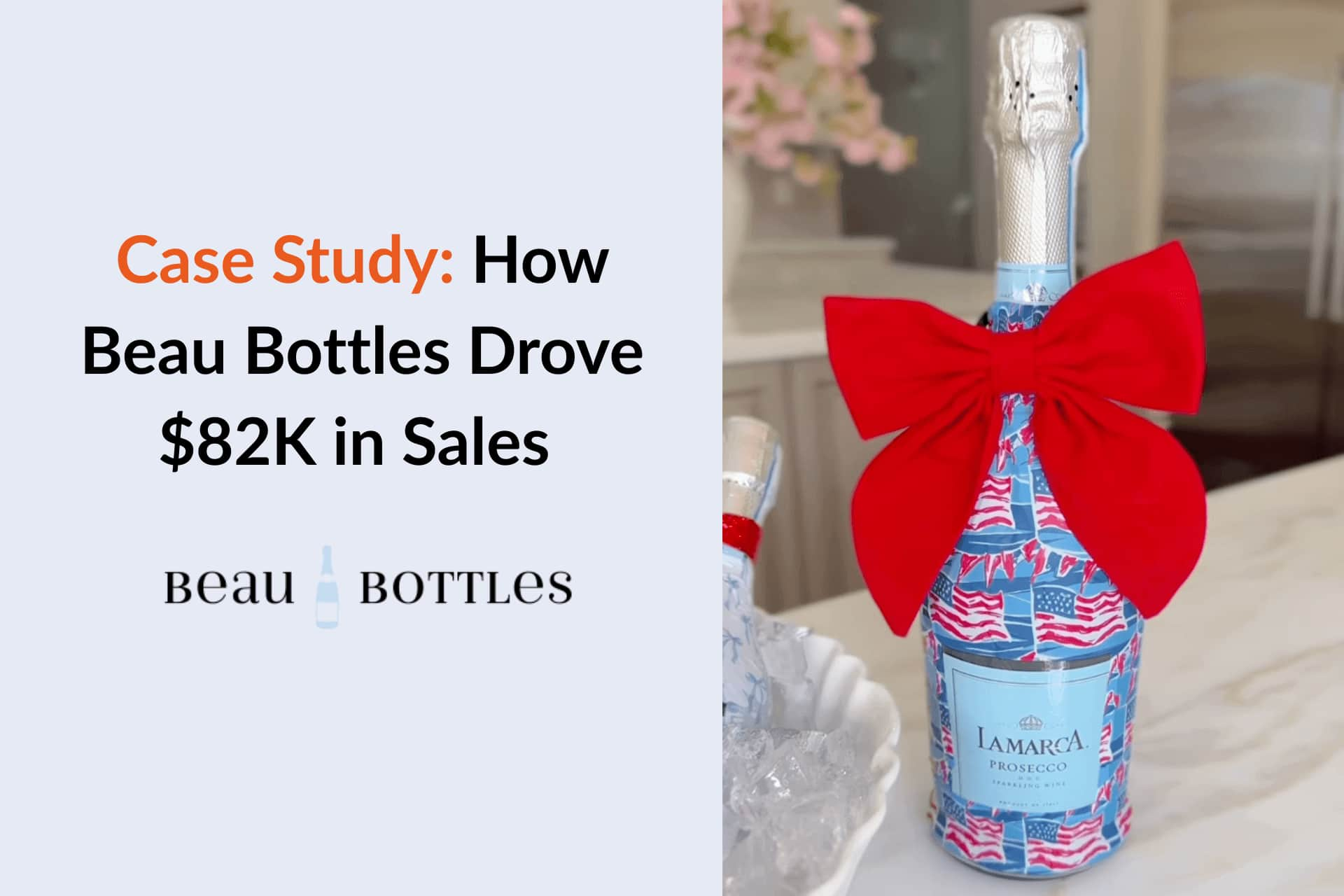





ULTB Creators has positioned itself as a tool for connecting brands with influencers. However, more and more marketers often encounter recurring issues such as unclear pricing structures, limited transparency in business operations, and a narrow market focus that caters mostly to agencies or IT-related niches. These concerns have led many businesses to search for more reliable, scalable, and transparent alternatives.
In this article, we’ll explore the Top 10 ULTB Alternatives, offering a detailed comparison to help you evaluate the best tools for your business:
Although ULTB Creators positions itself as a solution for influencer marketing, several recurring concerns have been highlighted in reviews and forums that push businesses to explore alternative platforms.
Some reviews raise concerns about the lack of responsiveness and transparency in communication—such as failure to address unsolicited emails or unsubscribing requests—undermining trust in the platform’s operational standards.
There are critiques regarding discrepancies in geographical or corporate identity details—such as claims to be a German company while evidence suggests different origins—which can raise doubts about credibility and authenticity.
While not always explicit, several platforms offering more transparent pricing models suggest that ULTB Creators may have higher or opaque cost structures, prompting retailers to look for clearer, budget-friendly alternatives. (Inferred from comparison listings) (influencer-hero.com)
ULTB Creators appears to cater primarily to specific B2B niches—such as agencies and IT service providers—based on limited user reviews; this may not align well with broader influencer marketing needs across diverse sectors.
Our comparison focuses on several key aspects:
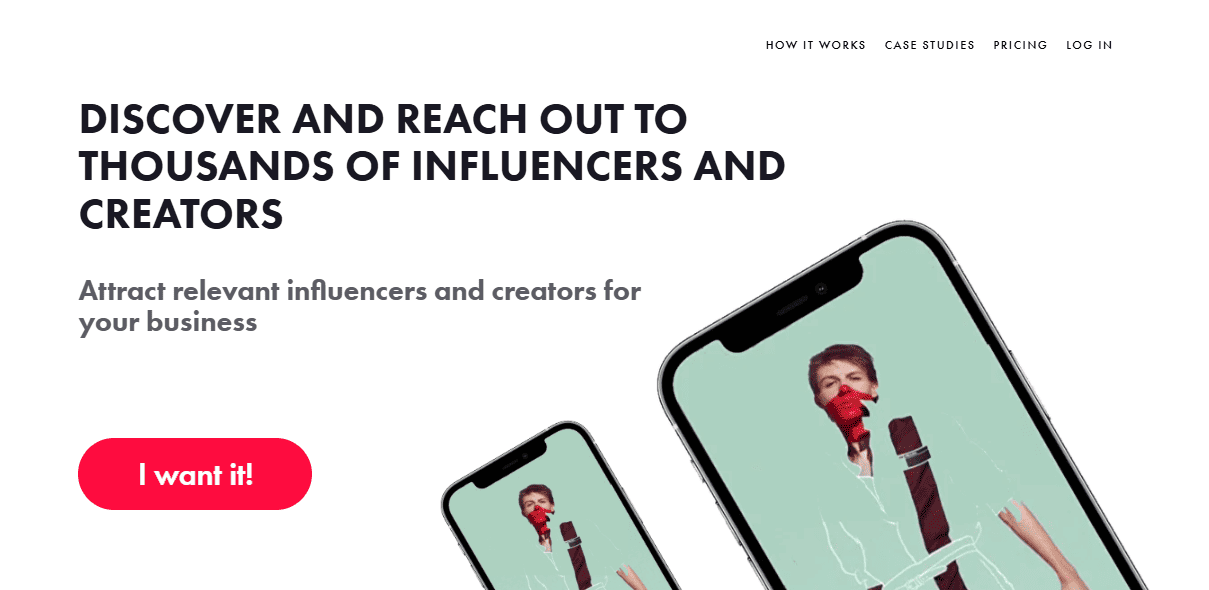
Best For: ULTB Creators is best for brands, agencies, and creator-economy platforms looking to outsource influencer recruitment and outreach at scale. It is particularly useful for teams that want verified creator contacts and done-for-you (DFY) outreach without building internal operations.
Platform Coverage:
Pricing:
Reviews: 4.4 / 5.0 (Trustpilot)
Ease of Use (UX/UI): As ULTB is primarily service-led rather than software-led, the user interface is minimal. Brands receive curated lists and DFY execution, with weekly check-ins and reporting in managed plans. This makes onboarding straightforward, though it lacks the full SaaS dashboard experience of other influencer platforms.
Customer Support: Customer support scales with plan type: basic email/chat support for entry-level data plans, while managed outreach includes a dedicated account manager, weekly 1:1 calls, and custom reporting. Consulting packages provide direct access to the founder for audits and deliverability reviews.
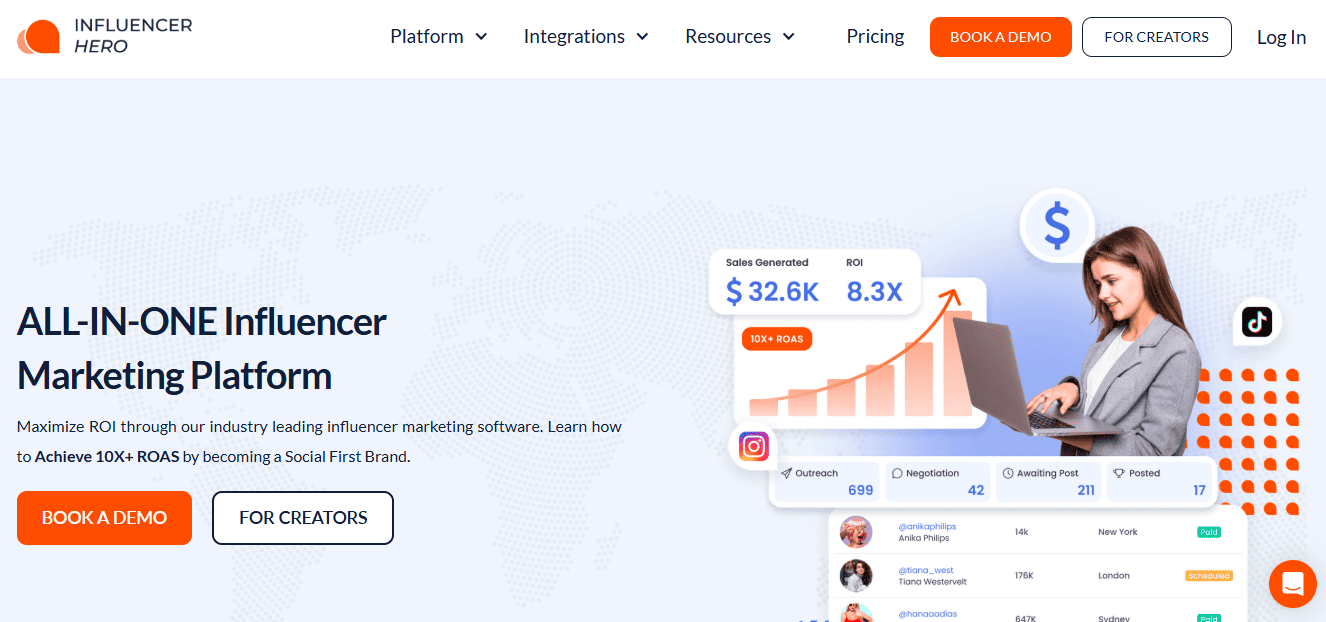
Best For: Influencer Hero is best for growing D2C/eCommerce brands that want an all-in-one, automation-first stack to scale influencer discovery, outreach, CRM, content collection, affiliate tracking, and ROI reporting across multiple social platforms.
Platform Coverage:
Pricing: Influencer Hero offers flexible pricing plans to accommodate growing brands. All plans include core features and can scale as the influencer program grows.
Reviews: 5.0 / 5.0 (Capterra)
Ease of Use (UX/UI): Influencer Hero is known for a clean, intuitive interface with a streamlined dashboard and drag-and-drop campaign setup. Teams highlight automated workflows and customizable email templates (plus a Chrome extension) that save hours each week.
Customer Support: Support is a core strength: 24/7 real-human live chat and responsive email, an in-platform Help Center with written and video tutorials, and a dedicated account manager from day one. Optional strategy consultations are available; Pro users can also access a private Slack channel for faster, continuous support.
ULTB Creators operates as a managed service with “Creators Data” priced per email (≈$0.20–$0.30) and managed outreach starting from $2,890/month on a 3-month minimum; it also offers consulting packages. Influencer Hero publishes transparent monthly SaaS tiers from $649 to $2,490 with clear creator limits, enabling predictable budgeting and scale without service retainers.
ULTB focuses on done-for-you list building and email outreach (domains, sequencing, reply management), not a self-serve platform for briefs, content approvals, contracts, and payouts. Influencer Hero provides the end-to-end software—discovery → AI-personalized outreach → CRM → eCommerce gifting → affiliate/ROI analytics—so teams own relationships, data, and performance inside one system.
For organizations that value transparent pricing, in-house control, automation, and revenue attribution, Influencer Hero is the stronger fit. It consolidates operations across eight networks, integrates with Shopify/WooCommerce, supports affiliate and storefront workflows, and pairs a clean UX with white-glove support from day one.

Best For: Modash is best for eCommerce and growth teams that want a data-driven, self-serve platform to scale influencer discovery, outreach, CRM, tracking and affiliate payouts, especially when Shopify is the core commerce stack.
Platform Coverage:
Pricing: There are different plans and options.
Reviews: 4.7/5 (G2)
Ease of Use (UX/UI): The interface emphasizes fast shortlisting and clean handoffs: powerful filters (niche, captions, hashtags, audience traits) sit alongside lookalike and AI discovery to reduce manual research. Outreach runs from templated emails with Gmail/Outlook syncing, while status tracking (“Contacted,” “Negotiating,” “Confirmed”) and real-time dashboards keep collaboration and reporting in one place.
Customer Support: The deck highlights strong onboarding and ongoing support, with guidance on targeted lists, gifting via Shopify, and setting up affiliate tiers and payouts. Teams are encouraged to combine discovery features like Find Your Fans with focused outreach to lift reply and conversion rates.
ULTB Creators is a managed recruitment + outreach service—it delivers targeted creator lists and runs email sequences, domain setup, and reply management, with weekly check-ins and custom reporting. There is no full self-serve campaign suite (briefs, content approvals, contracts, payouts) because the motion is primarily data + DFY outreach. Modash, by contrast, is a self-serve SaaS: teams run discovery, outreach, CRM, content tracking, Shopify gifting, affiliate links/codes, and automated payouts directly in the platform.
ULTB lists Creators Data on a per-email basis (~$0.20–$0.30, 5-day delivery) and Managed Outreach starting from $2,890/month with a 3-month minimum and 3,000+ creators contacted/month; consulting packages are also offered. Modash publishes transparent tiers—Essentials $199/mo and Performance $499/mo (annual billing), with enterprise options—plus plan limits like profile views, email unlocks, tracked creators, and seats. For predictable, in-house execution with lower fixed software cost, Modash is typically the more budget-friendly, scalable path; ULTB fits teams that prefer to outsource the outreach engine.
Choose ULTB if success depends on hands-off email recruitment and you want a partner to own domains, copy, and reply handling. Choose Modash if success depends on owning the workflow—from precise discovery and AI-assisted research to commerce-tied gifting, affiliate programs, and automated payouts—with full visibility and control in a single tool.

Best For: Upfluence is best for eCommerce brands on platforms like Shopify and Amazon that want an all-in-one influencer marketing solution. It’s particularly strong for teams that need to track ROI by connecting influencer campaigns directly to online sales.
Platform Coverage:
Pricing:
Reviews: 4.5/5 (G2)
Ease of Use (UX/UI): Upfluence offers a robust dashboard combining influencer discovery, CRM, outreach, and reporting. While many praise its comprehensive functionality, some mention a steep learning curve for beginners due to the large number of features. Once set up, the streamlined workflows reduce the need for third-party tools and centralize campaign management.
Customer Support: Upfluence provides account managers and onboarding support, ensuring that brands get up to speed quickly. Users often note that customer support is responsive and knowledgeable, especially for eCommerce-specific integrations. However, the platform requires an annual contract, so ongoing support is essential to maintain satisfaction throughout the year.
ULTB Creators and Upfluence take very different approaches to influencer marketing. ULTB is a service-first model focused on building targeted lists and handling outreach on behalf of brands, with pricing starting at $0.20–$0.30 per email for data plans and $2,890/month for managed outreach. It’s best suited for teams that want speed, verified contacts, and minimal in-house operations, but it lacks a self-serve SaaS dashboard and eCommerce integrations.
Upfluence, on the other hand, is a software-first model designed as a complete influencer marketing suite. At $1,276/month (annual contract), it offers influencer discovery, outreach automation, CRM, social listening, and full Shopify/Amazon integrations. This makes it better for eCommerce brands that need to directly link influencer campaigns to sales performance.
In short, choose ULTB if you want managed recruitment and outreach with minimal setup, and pick Upfluence if you need a scalable, integrated platform with advanced analytics, CRM, and eCommerce ROI tracking.

Best For: Captiv8 is best for mid-market and enterprise teams that need deep discovery, competitive intelligence, and advanced, shareable reporting across multi-campaign programs—plus optional creator commerce via storefronts and affiliate add-ons.
Platform Coverage:
Pricing: There are different pricing options:
Reviews: 4.1/5 (G2)
Ease of Use (UX/UI): The workflow is collaboration-first: teams can run multiple campaigns, approve/discard creators together, comment directly on creator profiles, and chat with creators without leaving the platform. Filter locking prevents rebuilding complex searches, and drag-and-drop metrics with public report links make stakeholder reporting straightforward. Smaller teams may find the breadth of options heavier than lightweight UGC tools.
Customer Support: The deck focuses on enterprise deployments and a managed path for Storefronts + Affiliate. It also references community posts alleging customer-service and payment issues—an area buyers should clarify with SLAs and payout workflows during evaluation.
ULTB Creators is a managed recruitment + outreach service. It builds targeted lists and runs email sequences, domain setup, and reply management, with weekly 1:1s and custom reporting. There is no full self-serve campaign suite (briefs, content approvals, contracts, payouts). Captiv8 is a software platform: in-house teams operate discovery, collaboration, tracking, and shareable analytics, with optional Storefronts + Affiliate to extend into creator commerce.
ULTB lists per-email pricing for data (≈$0.20–$0.30; five-day delivery) and Managed Outreach starting from $2,890/month on a three-month minimum with 3,000+ creators contacted/month. Captiv8 requires $25,000 annually (annual-only) plus $3,000 onboarding; the Storefronts + Affiliate bundle is an additional $20–30K/month. Teams seeking lower fixed software spend and self-operation usually weigh SaaS tools with transparent tiers; teams prioritizing outsourced email acquisition consider ULTB, while those needing enterprise-grade analytics and collaboration look to Captiv8.
Choose ULTB if success depends on hands-off email recruitment without building internal outreach operations. Choose Captiv8 when the priority is insight-led, multi-campaign management with competitive tracking and exec-ready reporting, and the budget supports enterprise pricing; add Storefronts + Affiliate if creator commerce is in scope.

Best For: CreatorIQ is best suited for large enterprises, global brands, and agencies that need a robust end-to-end influencer marketing solution. It’s particularly strong for companies managing high-volume campaigns across multiple platforms with advanced compliance, reporting, and financial workflows.
Platform Coverage:
Pricing: There are different plans:
Reviews: 4.7/5 (G2)
Ease of Use (UX/UI): Users describe CreatorIQ’s interface as comprehensive but initially complex due to the breadth of features. Once onboarded, the customizable dashboards and structured workflows make campaign management highly efficient. Many highlight the real-time data sync and live reporting links as particularly helpful for collaboration with stakeholders.
Customer Support: CreatorIQ offers dedicated implementation managers and customer success teams, which users praise for strategic input and proactive communication. Quarterly planning and onboarding support ensure brands maximize the tool’s capabilities, making customer service a standout element.
While ULTB focuses on managed outreach and quick creator recruitment through pre-built lists and done-for-you campaigns, CreatorIQ positions itself as a full-stack influencer SaaS platform. ULTB’s strength lies in affordability for data-only packages and fast creator sourcing, making it suitable for brands that want immediate outreach without building internal systems.
In contrast, CreatorIQ requires higher investment, with annual contracts typically ranging between $2K–$5K/month depending on the plan. This pricing gives access to enterprise-level workflows, including advanced analytics, CRM, creator payments, and deep platform integrations.
For smaller teams seeking cost flexibility, ULTB may be the better entry option. For enterprises looking for scalability, compliance, and long-term influencer infrastructure, CreatorIQ is the stronger choice.

Best For: HypeAuditor is best for brands and agencies that need data-rich discovery, outreach/CRM, and measurable attribution across Instagram, TikTok, YouTube, Twitch, X, and Snapchat—complete with Shopify and PayPal connections for commerce reporting.
Platform Coverage:
Pricing: HypeAuditor’s pricing is customizable, with the standard “Business” plan starting at around $10,000/year. Pricing can be adjusted based on the number of reports, active campaigns, and platform usage. They also offer a 24–48 hour free trial for new users.
Reviews: 4.6/5 (G2)
Ease of Use (UX/UI): The workflow covers the full arc so teams don’t have to juggle multiple tools. AI category detection, lookalike search, saved lists, and bulk messaging reduce manual effort during sourcing and outreach. Final reports are shareable via link or PDF, which keeps internal and client updates simple.
Customer Support: HypeAuditor provides onboarding and ongoing support, with a free trial for hands-on testing before committing. Support spans discovery tactics, campaign setup, contracts/e-sign, and eCommerce tracking, helping teams configure the stack for both interaction KPIs and order-level ROI.
ULTB Creators is a managed recruitment + outreach service—it sources lists, sets up domains, writes sequences, runs email campaigns, and manages replies, with weekly check-ins and custom reporting. It is not a full self-serve campaign suite for briefs, content approvals, contracts, or payouts. HypeAuditor is a software platform that brings those elements in-house: teams run discovery, outreach/CRM, contracts/e-sign, content approvals, and commerce/ROI tracking themselves.
ULTB offers per-email data lists (≈$0.20–$0.30 each, ~5-day delivery) and Managed Outreach starting from $2,890/month with a 3-month minimum and 3,000+ creators contacted/month, plus optional consulting. HypeAuditor provides a 24–48h free trial and customizable plans, with a commonly referenced Business plan near $10K/year (e.g., 2,000 reports). The former suits teams that prefer to outsource the outreach engine; the latter fits teams budgeting for predictable SaaS and wishing to own operations and attribution.
Pick ULTB when success hinges on hands-off email recruitment and speed without building internal outreach ops. Pick HypeAuditor when success depends on research depth and end-to-end program ownership—from AI-assisted discovery and social listening to Shopify/PayPal-tied ROI and shareable executive reporting.

Best For: GRIN is best for eCommerce and DTC brands that want to scale influencer and creator marketing programs while keeping ownership of their data and relationships. It is particularly strong for brands that prioritize long-term influencer partnerships and want integrations with eCommerce platforms like Shopify, WooCommerce, and Magento.
Platform Coverage:
Pricing:
Reviews: 4.5 / 5.0 (G2)
Ease of Use (UX/UI): Users often highlight GRIN’s clean, professional interface and the fact that workflows are centralized in one dashboard. Managing campaigns, communications, and payments feels streamlined once onboarded. However, some mention that because GRIN is a robust all-in-one platform, the learning curve can be steep initially, especially for smaller teams.
Customer Support: Customer support is considered responsive and knowledgeable, with dedicated account managers helping brands set up and optimize campaigns. Users appreciate the onboarding support and hands-on guidance. That said, some reviews mention that response times can vary during peak campaign seasons, and advanced technical troubleshooting can sometimes take longer.
While both ULTB and GRIN help brands streamline influencer marketing, their positioning and pricing differ significantly. GRIN is an enterprise-level, all-in-one platform with deep integrations into eCommerce ecosystems, advanced CRM, and robust analytics. It’s well-suited for established brands with larger budgets that want everything under one roof.
By contrast, ULTB positions itself as a more cost-effective solution with a strong focus on simplifying influencer campaigns for smaller teams or emerging brands. Its lower pricing makes it attractive to companies that don’t yet need GRIN’s enterprise-level functionality.
Users should choose GRIN if they want a comprehensive platform with advanced integrations and reporting, and are willing to invest in higher pricing for scalability. Meanwhile, ULTB is better for budget-conscious brands looking for an accessible entry point into influencer marketing without sacrificing essential features.
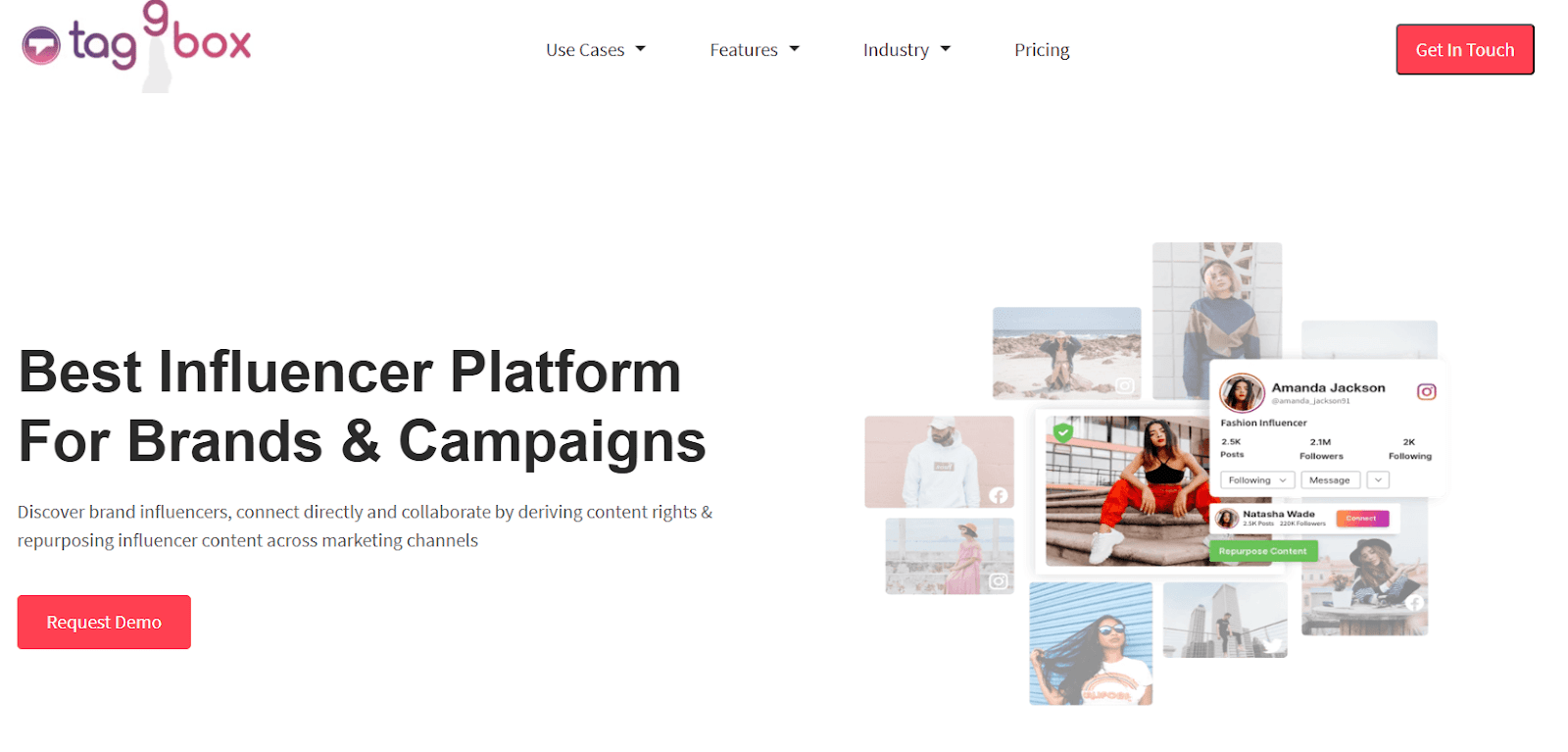
Best For: Taggbox is best for brands, retailers, hospitality, education, and agencies that want to collect, manage, and repurpose UGC at scale—then embed it across websites, product pages, events, and digital signage. It also supports influencer discovery and connections, but it’s not positioned as a full influencer CRM.
Platform Coverage:
Pricing: Taggbox offers four main subscription plans, each with higher feed limits, faster content updates, and expanded moderation tools.
Reviews: 4.8 / 5.0 (G2)
Ease of Use (UX/UI): Setup is straightforward for building multi-network feeds, moderating UGC, and embedding widgets. The dashboard helps organize content and track performance, though some advanced analytics may require manual reporting. Noted friction points include navigation that can feel unintuitive and plan/product switches that may take up to a day to fully apply.
Customer Support: Paid plans highlight responsive chat/call support and helpful docs/video tutorials that make onboarding easier; the Free plan leans more on self-service. Some teams mention minor technical glitches or incomplete post capture, so it’s wise to confirm SLAs if campaigns are time-sensitive.
ULTB Creators is a managed recruitment + outreach service—it sources targeted creator lists and runs email sequences, domain setup, and reply management, with weekly 1:1s and custom reporting. Taggbox is a UGC aggregation and rights-management platform with discovery and embeddable, shoppable widgets for distributing social proof across web and events; it is not a full influencer CRM.
ULTB’s Creators Data is priced per email (≈$0.20–$0.30; ~5-day delivery), and Managed Outreach starts from $2,890/month with a 3-month minimum and 3,000+ creators contacted/month. Taggbox publishes transparent UGC-widget plans from Free ($0) to Advanced ($79/month), scaling feeds, views, update frequency, and support level. The former fits teams that want to outsource email recruitment; the latter suits teams optimizing on-site social proof and shoppable UGC at a comparatively low fixed cost.
Choose ULTB when the priority is hands-off creator acquisition without building internal outreach ops. Choose Taggbox when the priority is UGC collection, rights, and distribution—embedding real customer content across your site and campaigns to lift conversion, while managing legal reuse in a single hub
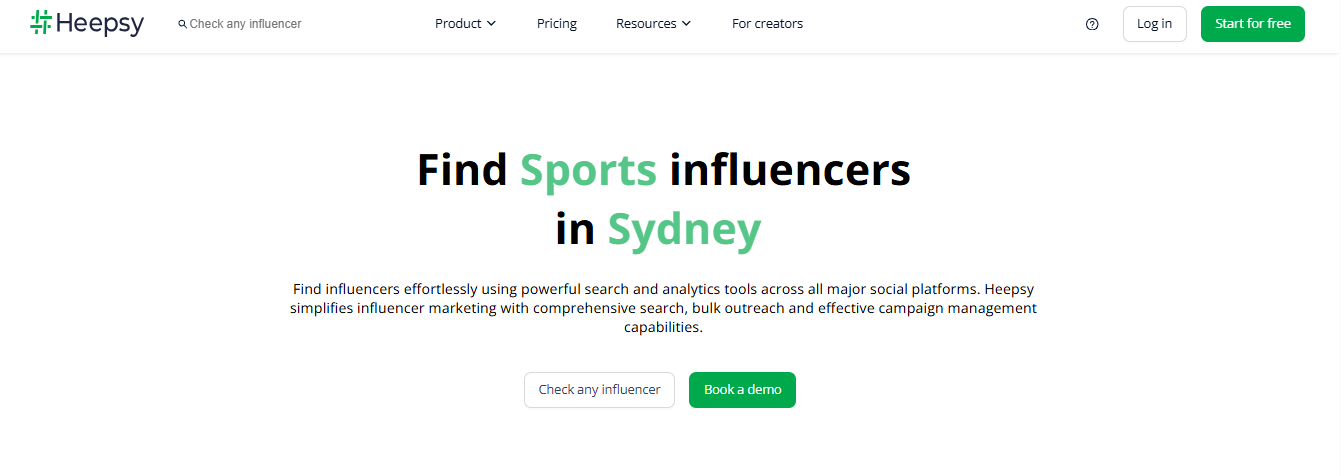
Best For: Heepsy is best for small to mid-sized businesses, agencies, and brands looking for a cost-effective way to identify and evaluate influencers. It’s particularly useful for companies wanting quick influencer search capabilities with a strong focus on data-driven decision-making.
Platform coverage:
Pricing & Commitment: There are different plans:
Reviews: 4.5 / 5 (G2)
Ease of Use (UX/UI): Users generally find Heepsy intuitive and straightforward, thanks to its clean interface and easy-to-use filters. The platform is designed to make influencer discovery quick, even for those new to influencer marketing. However, some reviewers note that its advanced features can feel limited compared to more enterprise-level platforms.
Customer Support: Customer support is described as responsive and helpful, with a team available to answer questions through chat and email. Many users appreciate the guidance they receive during onboarding. That said, some report that support is more reactive than proactive, particularly for lower-tier subscription plans.
When comparing ULTB to Heepsy, the biggest difference lies in scope and pricing. Heepsy is a cost-effective solution, ideal for businesses or agencies that mainly need influencer discovery, authenticity checks, and basic analytics. However, it lacks campaign execution tools, built-in payments, and native eCommerce integrations.
On the other hand, ULTB positions itself as a more complete influencer management and campaign execution suite, including outreach automation, UGC rights management, and integrations tailored for scaling. While ULTB typically comes at a higher price point than Heepsy, it delivers more advanced functionality for brands that want an end-to-end influencer marketing solution rather than just discovery and analytics.
Ultimately, brands should choose Heepsy if affordability and ease of use for discovery are the top priorities, and ULTB if they want a scalable, all-in-one platform with deeper campaign management capabilities.
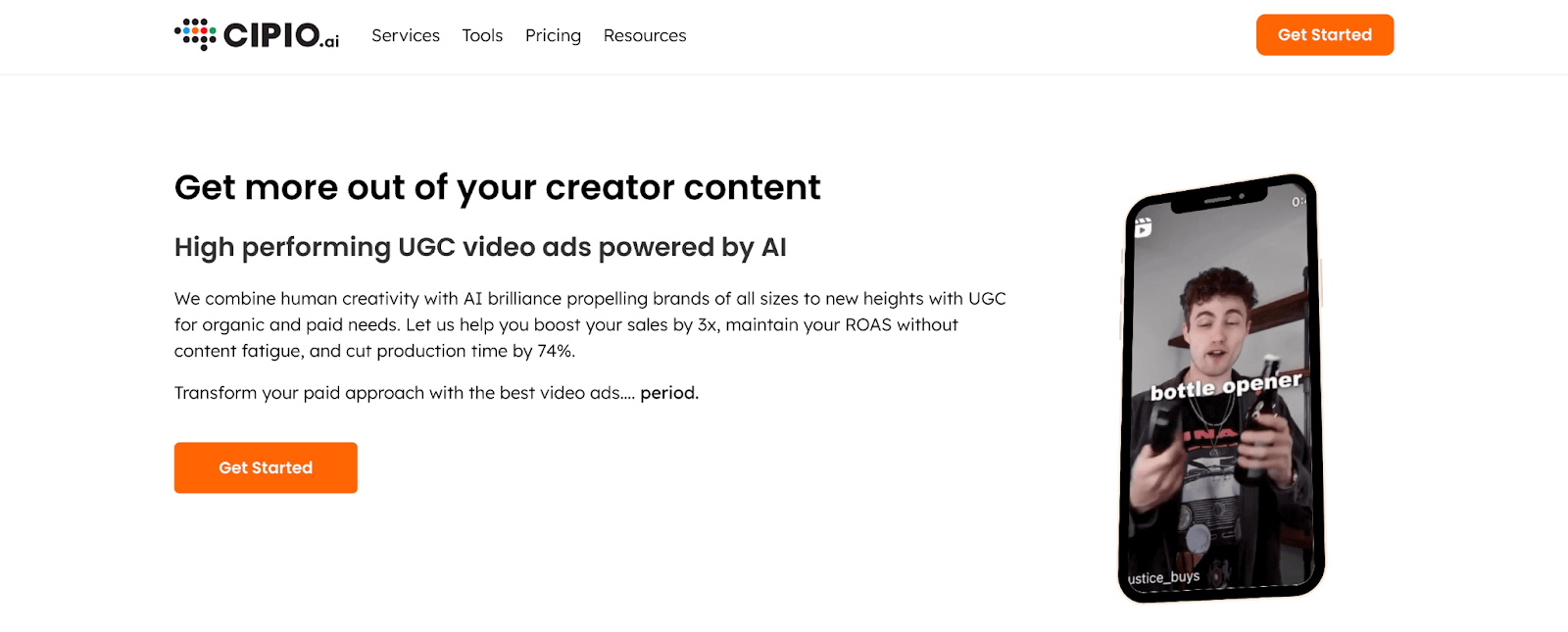
Best For: Cipio is best for Shopify/Amazon-focused eCommerce brands that want a fully managed UGC pipeline—from creator sourcing and gifting to producing ad-ready creatives and re-licensing content for paid and organic channels—without building in-house influencer operations.
Platform Coverage: While its main focus is Instagram, Cipio-created content can be repurposed for use across Facebook, TikTok, YouTube, and paid social ads, depending on the brand's distribution strategy.
Pricing: Cipio offers three flexible pricing models.
Pay-As-You-Go:
(No contract required; billed monthly based on usage.)
Quarterly Plan (min. 15 creators & 18 ads):
Annual Plan (min. 60 creators & 72 ads):
Reviews: 4.9 / 5.0 (Glassdoor)
Ease of Use (UX/UI): The experience leans service-first: teams get a clean interface for asset visibility but less hands-on control over outreach and analytics compared with self-serve influencer platforms. This model suits lean teams; however, practitioners who prefer self-serve dashboards and granular customization may find the tooling limited.
Customer Support: Brands highlight responsive account managers who proactively source creators and keep campaigns moving. A recurring wish is greater transparency into creator communications and progress so marketers don’t have to rely entirely on Cipio’s internal team for status.
ULTB Creators is a managed recruitment + email-outreach service: it delivers verified contacts, sets up sending domains, writes sequences, runs campaigns, and manages replies, with weekly 1:1s and custom reporting. Cipio is a managed UGC production and ads engine: it sources creators, runs gifting, and turns content into performance-ready ad creatives with full licensing for reuse. If the goal is hands-off creator acquisition via email at scale, ULTB aligns; if the goal is hands-off UGC creation and ad production, Cipio aligns.
ULTB offers per-email data lists (~$0.20–$0.30; ~5-day delivery) and Managed Outreach starting from $2,890/month on a three-month minimum with 3,000+ creators contacted/month. Cipio is usage-based on per-creator and per-ad pricing ($149/creator, $459/ad pay-as-you-go), with discounted quarterly and annual options (e.g., $129/$349 and $99/$299, respectively) tied to minimum volumes. Teams weighing outreach scale vs. creative output can pick the model that maps to current KPIs and budget discipline.
Select ULTB to accelerate top-of-funnel creator recruitment without building internal deliverability and reply-handling. Select Cipio when success hinges on continuous UGC supply and ad iteration with clear usage rights and a managed path from seeding to performance creatives; just confirm reporting depth and the level of in-platform control needed before committing.
When looking for ULTB alternatives, brands and agencies have plenty of options based on budget and scale. Tools like Heepsy and Modash shine in affordability and influencer discovery, while platforms such as Grin and CreatorIQ cater to enterprise-level campaign management.
Among them, Influencer Hero stands out as a top ULTB alternative. With a full suite of features—covering influencer discovery, CRM, outreach automation, reporting, analytics, gifting, UGC management, and affiliate payments—it eliminates the need for multiple tools.
For brands that want to scale influencer marketing without complexity, Influencer Hero delivers everything in one seamless platform. Book a demo today to see why it’s trusted as one of the best all-in-one solutions!

Some of the top alternatives to ULTB include Influencer Hero, Grin, Modash, Heepsy, and CreatorIQ. Among these, Influencer Hero stands out as a complete all-in-one solution offering influencer discovery, CRM, outreach, reporting, analytics, UGC management, gifting, and affiliate payments in a single platform. This makes it a strong option for brands looking to streamline influencer marketing without juggling multiple tools.
While ULTB provides valuable features, many brands find limitations in scalability, pricing, or lack of certain integrations. Alternatives like Influencer Hero not only cover all the basics but also add advanced functionalities like storefronts, affiliate management, and automated outreach—helping brands save time, cut costs, and manage campaigns more efficiently.
For eCommerce-focused brands, Influencer Hero is one of the best ULTB alternatives because it combines influencer discovery with affiliate payments and storefront capabilities, making it easy to track ROI from influencer partnerships. Grin and Upfluence are also popular choices for large eCommerce businesses, while Modash offers affordable discovery tools for smaller brands.
Pricing varies significantly between platforms. ULTB alternatives like Influencer Hero offer flexible packages tailored to both growing brands and enterprises, ensuring scalability without unnecessary costs. Meanwhile, tools like Modash and Heepsy are more budget-friendly for discovery-only needs, while enterprise-level solutions like CreatorIQ and Grin come with higher price tags due to their advanced integrations and features.
If you’re looking for an all-in-one solution, Influencer Hero is one of the most complete ULTB alternatives. It covers every stage of influencer marketing—from discovery to payments—while many other competitors specialize only in specific areas (like Heepsy in discovery or Taggbox in UGC). This makes Influencer Hero especially attractive for brands that want to manage everything in one place.



Schedule a Demo with one of our media experts below.